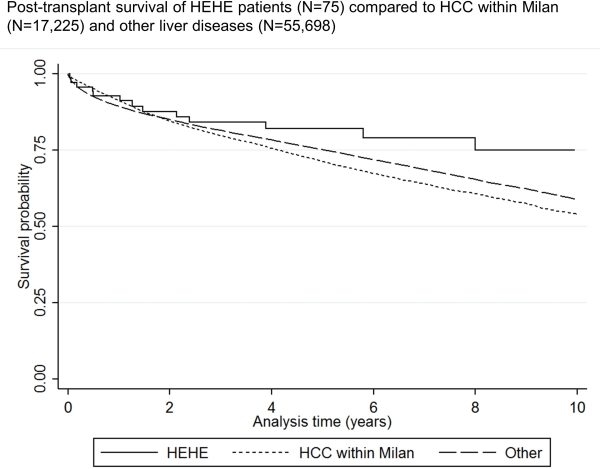Outcomes of Liver Transplantation for Hepatic Epithelioid Hemangioendothelioma in the U.S. (2002-2015)
1Division of Gastroenterology, University of Pennsylvania, Philadelphia, PA
2Division of Transplant Surgery, University of Pennsylvania, Philadelphia, PA
3Center for Clinical Epidemiology and Biostatistics, University of Pennsylvania, Philadelphia, PA.
Meeting: 2018 American Transplant Congress
Abstract number: C230
Keywords: Liver transplantation
Session Information
Session Name: Poster Session C: Liver: Recipient Selection
Session Type: Poster Session
Date: Monday, June 4, 2018
Session Time: 6:00pm-7:00pm
 Presentation Time: 6:00pm-7:00pm
Presentation Time: 6:00pm-7:00pm
Location: Hall 4EF
Hepatic epithelioid hemangioendothelioma (HEHE) is a rare, malignant vascular tumor of the liver with high mortality if left untreated. Liver transplantation (LT) is potentially curative, however national outcomes in the Model for End-stage Liver Disease (MELD) allocation era warrant further study. This was a retrospective cohort study using the United Network for Organ Sharing (UNOS) transplant database. From 2/27/02-12/31/15, 116 adults waitlisted for LT with HEHE were identified as per free text entry, allowing for greater accuracy than the UNOS diagnosis code 4405 (also includes angiosarcoma and hemangiosarcoma). Patients with HEHE were more commonly female (70.7%), White (75%) and with a median age of 43 years (IQR: 34-51). Overall, 75 (64.6%) waitlisted HEHE patients underwent LT, of which 5 (6.7%) underwent living donor liver transplantation (LDLT), and 11 (14.7%) were removed from the waitlist due to death or being too sick. The median laboratory MELD score at LT was 7 (IQR: 6-11). Of the 75 patients transplanted, exception points were applied for in 71 (94.7%) with an approval rate of 97.2%. The median waitlist time was 64 days (IQR: 24-236). There was significant variation by UNOS region in the number of LTs for HEHE, ranging from 2 (2.7%) in region 1 to 16 (17.3%) in region 5. Of those transplanted, 54 (72%) were alive at the end of follow-up, while 13 (17.3%) were deceased and 5 (6.7%) required re-transplantation. Post-transplant survival for patients with HEHE was superior to patients with hepatocellular carcinoma within Milan criteria or for other reasons (see Figure; p<0.001). In conclusion, LT for HEHE offers acceptable post-LT outcomes. Due to their low laboratory MELD score, candidates with HEHE must receive waitlist priority via exception points to have access to deceased donor LT. HEHE should be considered an appropriate use of exception points in developing the upcoming UNOS national review board process. 
CITATION INFORMATION: Bittermann T., Prenner S., Abt P., Goldberg D. Outcomes of Liver Transplantation for Hepatic Epithelioid Hemangioendothelioma in the U.S. (2002-2015) Am J Transplant. 2017;17 (suppl 3).
To cite this abstract in AMA style:
Bittermann T, Prenner S, Abt P, Goldberg D. Outcomes of Liver Transplantation for Hepatic Epithelioid Hemangioendothelioma in the U.S. (2002-2015) [abstract]. https://atcmeetingabstracts.com/abstract/outcomes-of-liver-transplantation-for-hepatic-epithelioid-hemangioendothelioma-in-the-u-s-2002-2015/. Accessed December 14, 2025.« Back to 2018 American Transplant Congress
